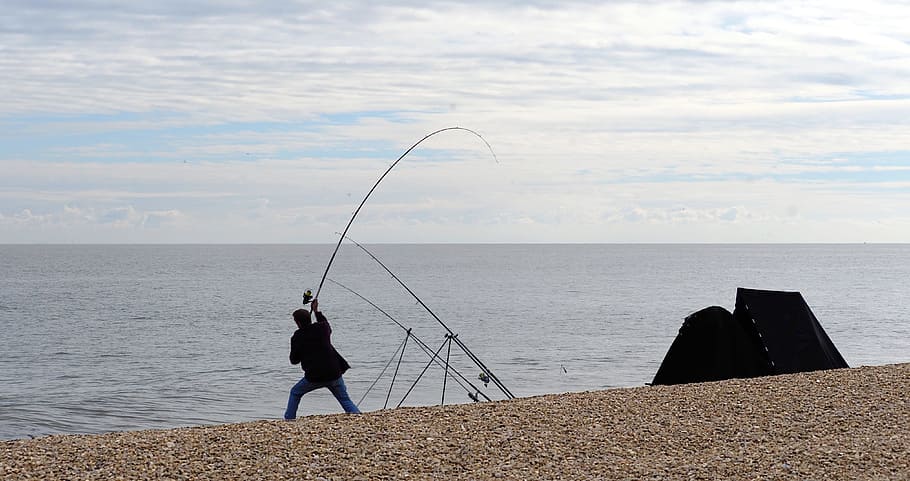Six Rules About Fly Fishing Cast Meant To Be Damaged
Fly line is far thicker, as a result of there’s no weight ultimately of the line, just a fly. Make it possible for the line guide is in its proper position, and do not let it get past its supposed position throughout your forged by utilizing your thumb as a guide for a way much slack you have to be releasing. 4. Do not let go of the road until you launch the solid.
 6. Pull the rod back and over the shoulder of the arm you're using to forged. Also, don’t raise your arm too excessive as it's going to pressure your shoulder. 3. Extend the first finger of the reel hand downwards to the spool to gather the road in front of the bail arm.
6. Pull the rod back and over the shoulder of the arm you're using to forged. Also, don’t raise your arm too excessive as it's going to pressure your shoulder. 3. Extend the first finger of the reel hand downwards to the spool to gather the road in front of the bail arm.
4. Raise your casting arm till your hand is on your face-level. Also, it serves the identical function as a casting bubble in that it assists with weight. How you release the ball is similar method you take away the thumb when casting. In essence, it’s necessary to guantee that the hold is agency, however relaxed just in the identical approach you’d hold a golf membership.
1. To carry a spinning reel entirely for casting, slip your hand around the reel seat. Hold the rod handle in a cushty waist-degree position. 7. Ensure the rod strikes on a horizontal path somewhat than up and down. Ensure you're holding the rod together with your dominant hand.
3. Press firmly on the reel button using the thumb of the dominant hand holding the rod. That bit of line off the reel will feed the length of line you have got for casting. You will need to bend your wrist whereas casting. THIS Would require YOU TO BEND YOUR WRIST. The wrist hinges shortly sufficient to increase the road utterly, however not so fast you can’t feel the rod bend.
The rod handle should maintain above the waist all the time. The rod tip should be faintly (30 levels) above the goal. Look out to sea within the route you want to cast, and imagine a goal in the sky at about 45 degrees elevation and just a little to the fitting of the casting route. 5. Reverse your hand with the rod a bit and quickly candy the rod previous your face stopping at 30 degrees above floor.
One in all an important steps, when you’re ready to solid, is to ensure that both your physique and fishing rod straight face the route that you’re planning to forged your bait or lure. Before beginning, all the time get into the above physique position. That is the important and ideal body place and technique for casting a fishing rod.
A heavier rod provides you with more casting distance, but it may be difficult to set the hook with a stiffer rod. For example, whenever you load a 12 ft rod, the tip of the rod travels extra distance than when you cast a 10 ft rod. 2. Allow an adequate quantity of line to dangle from the tip to supply slightly weight, ideally about 5-15 inches.
Once you press, the line will fly out of the spool. It can be tough to figure out how to drift your fly accurately and land those big catches. But add the line’s size if you're using a sinker because it can make your line too quick, causing a low cast. Novices typically over-hinge the wrist, causing the rod tip to pass beyond the 10 and a pair of points.
1. Rotate the reel crank clockwise till the bait is about 1 foot from the rod tip. 2. Place your thumb slightly before the reel button and grip the handle of the rod. If you are proper handed, put the rod in your left. Many fishermen decide to use this one when they are trying to cast around a rock or towards a bank.
This length is perfect for a robust solid. Don’t know the way to forged? This solid is the basis of a collection of casts identified as the Speys. Casts longer than 160 toes or 50 meters are for the tremendous elite in casting, and nothing that anyone will receive under regular fishing situations.
Since spinning reels are typically used for lighter baits and extra finesse presentations, a superb rule of thumb is line dimension between 6 and 12 lb monofilament or fluorocarbon and 10 to 30 lb braid is strong for spinning rods. 7000 or 70 is a fishing reel size suitable for the likes of boat fishing rods, 10 or 12 foot beach rods, or even eight to 9 foot basic goal rods.